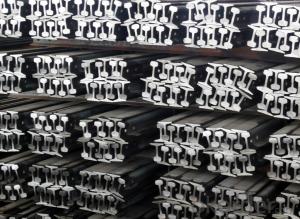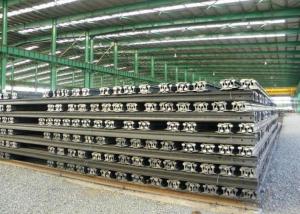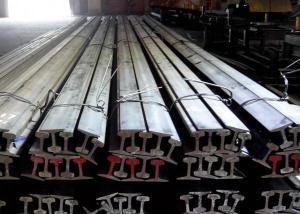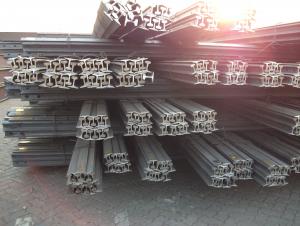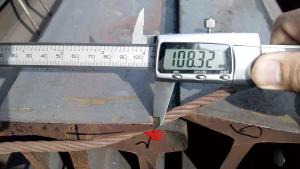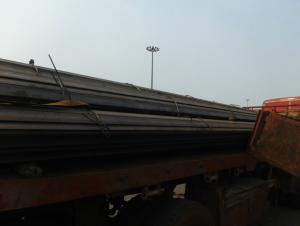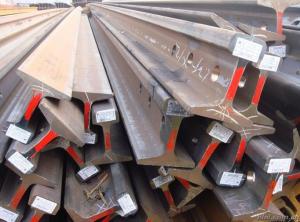Steel Light Rail Grade Q235
- Loading Port:
- China Main Port
- Payment Terms:
- TT or LC
- Min Order Qty:
- 50 m.t.
- Supply Capability:
- 5000 m.t./month
OKorder Service Pledge
OKorder Financial Service
You Might Also Like
Product Description:
OKorder is offering Steel Light Rail Grade Q235 at great prices with worldwide shipping. Our supplier is a world-class manufacturer of steel, with our products utilized the world over. OKorder annually supplies products to African, South American and Asian markets. We provide quotations within 24 hours of receiving an inquiry and guarantee competitive prices.
Product Applications:
Steel Light Rail Grade Q235 are ideal for structural applications and are widely used in forest region, Mines, factories and construction sites laid of the place such as temporary transport line and light motorcycles with line.etc.
Product Advantages:
OKorder's Steel Light Rail Grade Q235 are durable, strong, and wide variety of sizes.
Main Product Features:
· Premium quality
· Prompt delivery & seaworthy packing (30 days after receiving deposit)
· Mill test certification
· Professional Service
· Competitive pricing
Product Specifications:
Manufacture: Hot rolled
Grade: Q235, 55Q
Certificates: ISO, SGS, BV, CIQ
Length:6m, 12m,12.5m
Package: Packed in bundles and shipped by break bulk or containers.
LIGHT RAIL/HEAVY RAIL | Height (mm) | Bottom (mm) | Head width (mm) | Head height (mm) | Waist height | Bottom height (mm) | Waist thichness (mm) | Section cm2 | Mass: Kg/m |
9 | 63.50 | 63.50 | 32.10 | 17.48 | 35.72 | 10.30 | 5.90 | 11.30 | 8.94 |
12 | 69.85 | 69.85 | 38.10 | 19.85 | 37.70 | 12.30 | 7.54 | 15.54 | 12.2 |
15 | 79.37 | 79.37 | 42.86 | 22.22 | 43.65 | 13.50 | 8.33 | 19.33 | 15.2 |
22 | 93.66 | 93.66 | 50.80 | 26.99 | 50.00 | 16.67 | 10.72 | 28.39 | 22.3 |
30 | 107.95 | 107.95 | 60.33 | 30.95 | 57.55 | 19.45 | 12.30 | 38.32 | 30.1 |
FAQ:
Q1: How many tons of steel products could be loaded in containers?
A1: Usually the steel products are delivered by bulk vessel because of the large quantity and the freight. However, there are no bulk vessel enter some seaports so that we have to deliver the cargo by containers. The 6m steel product can be loaded in 20FT container, but the quantity is changed according to the size, usually from 18tons to 25tons.
Q2: How do we guarantee the quality of our products?
A2: We have established an advanced quality management system which conducts strict quality tests at every step, from raw materials to the final product. At the same time, we provide extensive follow-up service assurances as required.
Q3: How soon can we receive the product after purchase?
A3: Within three days of placing an order, we will arrange production. The normal sizes with the normal grade can be produced within one month. The specific shipping date is dependent upon international and government factors, the delivery to international main port about 45-60days.
Images:


- Q:Are steel rails used in tourist train operations?
- Tourist train operations often rely on the use of steel rails. These rails offer a robust and long-lasting track infrastructure, capable of withstanding the heavy loads and continuous usage typically associated with tourist trains. Their design ensures a smooth and secure journey for passengers, supporting the weight of the train and any additional equipment or amenities that enhance the tourist experience. Moreover, steel rails necessitate less maintenance in comparison to alternative track types, making them a cost-effective preference for tourist train operators.
- Q:Can steel rails be used for freight trains?
- Yes, steel rails are commonly used for freight trains. They provide durability and strength necessary to support the weight and movement of heavy freight cars.
- Q:How are steel rails protected against extreme weather conditions like snow and ice?
- Various methods are employed to safeguard steel rails from harsh weather conditions like snow and ice. One commonly used approach involves applying anti-icing agents or de-icing substances onto the rails. These substances are typically sprayed or spread on the rails before the arrival of winter to prevent the accumulation and adherence of ice and snow to the steel surface. Another method involves the utilization of specialized rail heaters. These heaters are installed along the tracks and are activated during cold weather to warm the rails and prevent ice formation. The heat generated by these heaters melts any snow or ice that may have gathered on the rails, guaranteeing a clear and secure pathway for trains. Moreover, rail operators often rely on snowplows and snow blowers to swiftly remove snow from the tracks. These machines are designed to efficiently eliminate snow and ice, thereby minimizing the risk of derailment or other disruptions caused by accumulation. Furthermore, regular maintenance of the railway infrastructure plays a vital role in protecting steel rails from extreme weather conditions. This includes inspecting and repairing any potential damage to the rails, such as cracks or corrosion, which can be exacerbated by snow and ice. Proper drainage systems are also crucial to prevent water from pooling and freezing on the tracks. To summarize, the protection of steel rails against snow and ice involves the use of anti-icing agents, rail heaters, snowplows, and regular maintenance. These measures ensure the safe and efficient operation of trains even in severe weather conditions.
- Q:How are steel rails maintained in high-traffic areas?
- Steel rails in high-traffic areas are maintained through regular inspections, cleaning, and lubrication. Specialized maintenance crews conduct visual inspections to identify any signs of wear, cracks, or other potential issues. They also use advanced equipment to measure the rail's alignment and ensure it meets safety standards. Cleaning is crucial to remove debris and prevent the accumulation of dirt that could affect the rail's performance. Additionally, lubricants are applied to reduce friction and wear, ensuring smoother train operation. These maintenance activities are typically performed on a scheduled basis to minimize disruption to train services and ensure the safety and efficiency of the rail system.
- Q:Can steel rails be used in areas with high levels of vibration?
- Steel rails can be used in areas with high levels of vibration, but additional measures must be taken to ensure their stability. Vibrations can cause fatigue and wear on steel rails, leading to potential damage and safety hazards. To mitigate these risks, various methods can be employed. Firstly, the design and construction of the rail system should consider the expected levels of vibration. This includes using appropriate rail profiles, ensuring proper alignment, and employing proper fastening methods. Additionally, the use of resilient rail fastening systems can help absorb and dampen vibrations, reducing their impact on the rails. Regular inspections and maintenance are also essential to monitor the condition of the rails and detect any signs of damage or wear. This can include visual inspections, track measurements, and monitoring of vibration levels. If necessary, repairs or replacements should be made promptly to prevent further deterioration. In some cases, alternative materials or technologies may be considered. For example, composite materials or elastomeric pads can be used as an alternative to steel rails to better absorb vibrations and reduce their impact. However, these alternatives may have their own limitations or require additional considerations in terms of cost, durability, and maintenance. In summary, while steel rails can be used in areas with high levels of vibration, it is crucial to implement appropriate design, construction, and maintenance practices to ensure their stability and safety. This may include the use of resilient fastening systems, regular inspections, and considering alternative materials if necessary.
- Q:What are the safety precautions when working with steel rails?
- When working with steel rails, it is important to follow several safety precautions. Firstly, wearing appropriate personal protective equipment (PPE) such as safety glasses, gloves, and steel-toed boots is essential to protect against potential hazards. Secondly, workers should be trained on proper handling techniques to avoid strains and injuries. It is crucial to use lifting equipment and proper body mechanics when moving heavy rails to prevent back injuries. Additionally, workers should be cautious of sharp edges and potential tripping hazards, ensuring a clean and organized work area. Finally, regular inspections and maintenance of the rails, including checking for any cracks or defects, should be conducted to ensure safe working conditions.
- Q:Why should there be a gap between the rails?
- Avoid the rail due to "expansion, contraction" and the track extrusion deformation (cold winter, the track will shrink because of the gap between the larger; hot summer rail due to heat and gap smaller).
- Q:How are steel rails inspected for cracks and defects?
- Steel rails are inspected for cracks and defects through a combination of visual inspections and non-destructive testing techniques such as ultrasonic testing, magnetic particle inspection, and eddy current testing.
- Q:What are the specifications for steel rail ballast?
- The specifications for steel rail ballast typically include specific weight requirements, particle size distribution, durability, and resistance to deformation. It should have a high specific gravity to provide stability and prevent lateral movement of the tracks. The particle size distribution is crucial to ensure proper drainage and stability, with a balance between larger stones for load distribution and smaller particles to fill voids. It should also exhibit durability and resistance to breakage, as well as resistance to deformation under the weight of passing trains.
- Q:What is the expected deflection of steel rails under load?
- The expected deflection of steel rails under load can vary depending on various factors such as the load magnitude, rail dimensions, support conditions, and material properties. However, steel rails are typically engineered to have minimal deflection under normal operating conditions to ensure stability and safety.
1. Manufacturer Overview |
|
|---|---|
| Location | |
| Year Established | |
| Annual Output Value | |
| Main Markets | |
| Company Certifications | |
2. Manufacturer Certificates |
|
|---|---|
| a) Certification Name | |
| Range | |
| Reference | |
| Validity Period | |
3. Manufacturer Capability |
|
|---|---|
| a)Trade Capacity | |
| Nearest Port | |
| Export Percentage | |
| No.of Employees in Trade Department | |
| Language Spoken: | |
| b)Factory Information | |
| Factory Size: | |
| No. of Production Lines | |
| Contract Manufacturing | |
| Product Price Range | |
Send your message to us
Steel Light Rail Grade Q235
- Loading Port:
- China Main Port
- Payment Terms:
- TT or LC
- Min Order Qty:
- 50 m.t.
- Supply Capability:
- 5000 m.t./month
OKorder Service Pledge
OKorder Financial Service
Similar products
New products
Hot products
Related keywords
